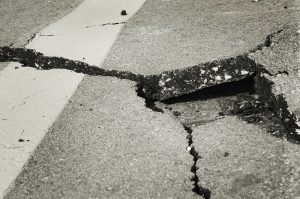
When dealing with both extremely high and extremely low temperatures concrete infrastructure can suffer from a variety of issues.
If you’re planning infrastructure made with concrete you may be surprised to learn that the temperature during construction matters. Concrete has many advantageous as a building material, but unless it’s installed correctly and in the right conditions you may risk encountering unexpected problems. When dealing with both extremely high and extremely low temperatures (such as above 100ºF or under 40ºF) concrete can suffer from a variety of issues.
Hot Weather
With summer temperatures starting to rise it’s important to take the heat’s effects on concrete into consideration before you begin construction. When you’re working with additional factors like large batch sizes or use of rapid-hardening cement the effects of heat can become even more detrimental. One issue that occurs is that with the higher temperature the concrete hydrates quickly causing accelerated setting and reduced workability. Higher temperatures and increased water evaporation speed can lead to additional problems as well, for one it becomes difficult to retain the amount of moisture needed for a uniform curing period, and the evaporation can cause rapid shrinkage causing cracking and introducing tensile stress.
Concrete made during high temperatures also suffers from reduced long-term strength and swifter deterioration than concrete made during cooler periods. Lastly, in the case of air-entrained concrete, higher temperatures mean that the amount of air becomes difficult to maintain. This can cause workability to be greatly reduced. The best way to prevent these issues is to limit work with fresh concrete to days where the temperature does not exceed 95º. Alternatively, use of chilled water or ice flakes in the mixing process can help with the process, however, this may not completely eliminate the risks.
Cold Weather
Working with concrete in cold temperatures creates its own unique set of risks that you definitely want to avoid. As water freezes it expands, it follows that if the water in your concrete mix freezes during the setting process you’ll encounter irreparable damage and reduced strength. Additionally, lower temperatures mean that development of strength and setting times are greatly affected. The time period for finished construction becomes significantly longer and forms will need to remain in place for extended periods.
If the temperature fluctuates significantly within the period, with numerous instances of freezing and thawing, the final result will be concrete that is significantly impaired. Not only will its strength and durability be affected, but the chances for cracking will be dramatically increased.
Bring Your Business to the Best
If you need help making sure your concrete work doesn’t suffer any of the above problems make sure you turn to the experts at Concrete Visions. Concrete Visions has over 12 years of experience and expertise in concrete scanning and we know how to detect any problems lurking beneath the surface. We use ground penetrating radar accurately and expertly and are familiar with many other methods that can be used when appropriate, like concrete x-ray and electromagnetic conductivity. We are also very familiar with the latest construction safety techniques and train all of our workers to do their work quickly, accurately, and safely. If you would like to learn more about how we can help you, give us a call at (410) 766-2210 or visit us online. For more articles and tips, follow us on Facebook, Twitter, LinkedIn, and Google+.
